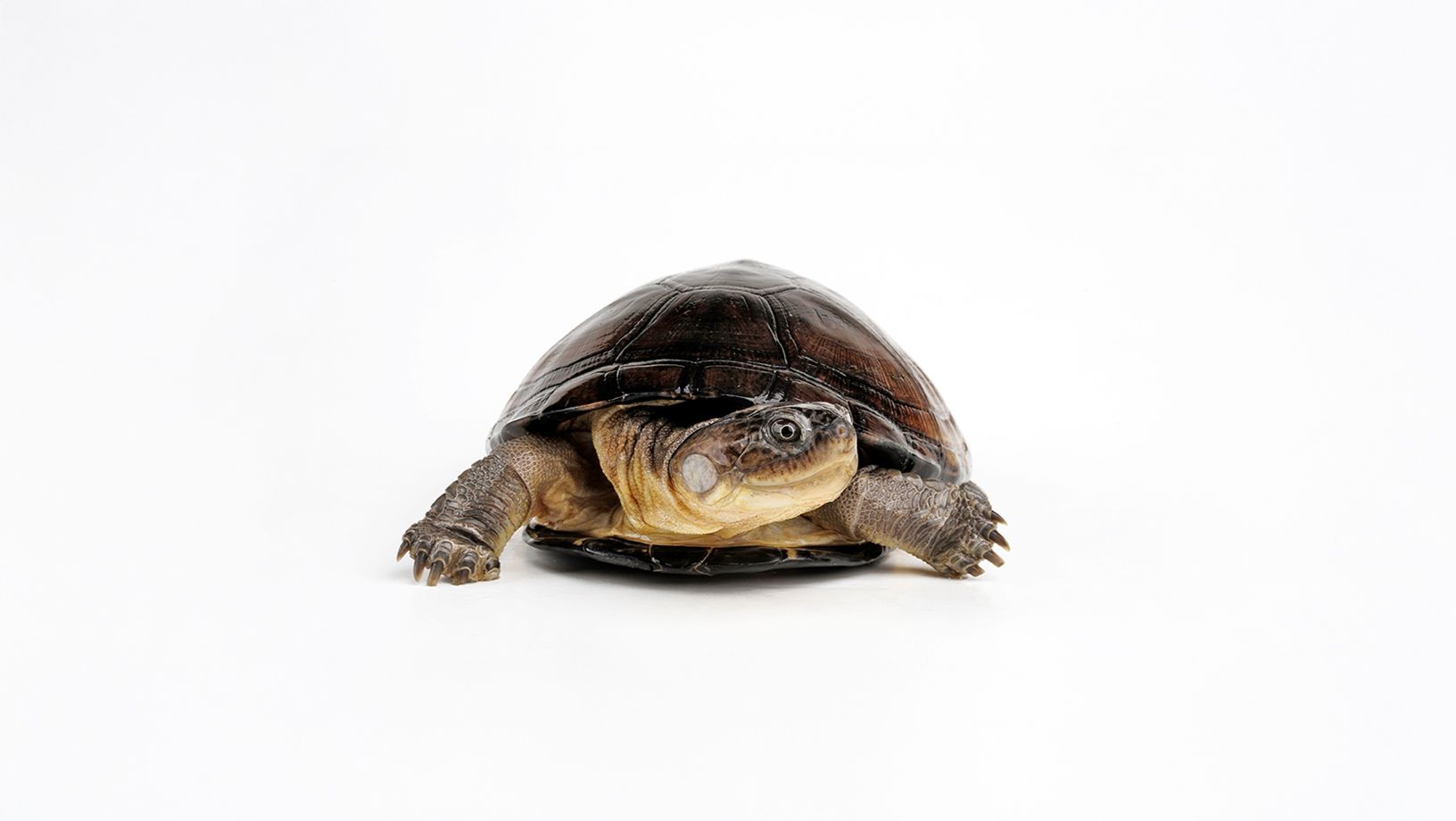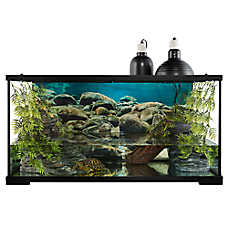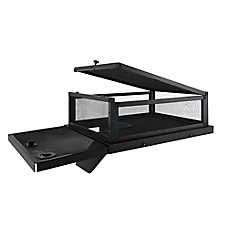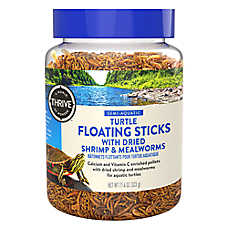African Side-Necked Turtle Care Guide

In this Article
Getting to Know African Side-Necked Turtles
African Side-necked turtles, as the name implies, are a freshwater variety of turtle native to western and central Africa. They live in shallow, murky water in the wild and can be found in rivers, lakes, and swamps. They got the name “side-necked” because unlike most other turtles who can fully retract their head into their shell, these adorable turtles fold their necks sideways under their shells.
Size: Adult African Side-necked turtles average 7” to 12” in length.
Scientific Name: Pelusios castaneus
Lifespan: On average, they live about 20 years, but there have been reports of some reaching 30 and even 50 years old!
Diet: Aquatic and semi-aquatic turtles are omnivores and eat assorted insects as well as plants.
Behavior: African Side-necked turtles are generally calm turtles. They are less likely to bite than some other species, preferring to retreat into their shell when startled. African Side-necked turtles are unique in that they do not shed their scutes (shell surface) like other turtles, and instead they shed their skin similarly to how lizards do!
Temperament: African Side-necked turtles can be a little timid and like to have numerous places to hide. They are not fond of being handled. However, they can learn to recognize their owners and may swim over when you approach or beg for food.They can be housed together, but care should be taken as turtles can become aggressive and territorial with each other if they do not have enough space or hiding places.
Note: All turtles are capable of biting. Use care when interacting with them, especially during feeding, when a finger may be mistaken for food.
How to Set Up an African Side-Necked Turtle Habitat
Typical Turtle Aquarium:
- Glass tank
- Tight-fitting tank cover
- Light fixture for
- Basking light
- UV-B Light
- Ambient Lighting
- Thermometer
- Hygrometer
- Appropriately-sized gravel or sand substrate
- Gravel must be too big to fit in the turtle’s mouth
- Dock or dry area
- Décor for hiding and enrichment
- Live or artificial plants
- Heater
- Filter
African Side-necked Turtles are considered semi-aquatic, meaning they live on both land and in water. African Side-necked turtles can be housed in a pond, a tank, or a paludarium (a terrarium containing both a land area and a submerged water area). See How To Set Up a Paludarium to learn more! Semi-aquatic turtles can live alongside larger fish, but use caution when as turtles can and will eat fish that fit in their mouths. Before introducing fish, review our Fish Compatibility Guide for tips on selecting safe species.
Here's how to build a proper home for your African Side-Necked Turtle:
1. Choose and Set Up the Habitat
- Pick your setup: A large glass tank or paludarium with both land and water areas is ideal. If you’re using a traditional tank, you’ll need to create a basking dock above the waterline.
- Size matters: Follow the general rule of 10 gallons per inch of shell length — and increase this if housing more than one turtle. Remember, your adult turtle may need a 100-gallon tank depending on its size when full grown!
- Substrate options: Use sand or gravel larger than your turtle’s head to avoid ingestion. Going substrate-free is also safe and easier to clean but limits natural digging behaviors. Substrate may also help maintain water quality since it is another surface for beneficial bacteria to grow on.
- Décor and enrichment: Add large rocks, sturdy plants, driftwood, or turtle-safe ornaments. Make sure your turtle has plenty of hiding spots and places to climb out of the water. Turtles need a place to leave the water and dry out at times.
- Lighting and heating:
- Two thermometers should be used above the water: one in the basking area and another in a cooler above water area. Install a UVB bulb and basking bulb above the dry dock. Turtles need a 12-hour day/night cycle, so use a timer to automate it.
- Filtration and temperature:
- Another thermometer should measure your water temperature. Choose a filter rated for your turtles appropriate for your tank size, and use an aquarium heater to maintain water at 75–80°F
- Cover securely: Use a tight-fitting lid and leave at least 6" of vertical space between the tallest point in the tank and the top to prevent your turtle from escaping.
2. Prep the Tank Before Adding Your Turtle
- Prepare your space: Place the aquarium on a flat, stable surface that can support its full weight - water weighs 8.3 pounds per gallon.
- Rinse and place décor: Rinse all substrate and decorations with tap water (never soap), then add to the tank.
- Substrate must be either sand or gravel larger than your turtle’s head. If the gravel is too small, your turtle may accidentally eat the rocks and this can cause a gastrointestinal blockage, potentially requiring surgery to resolve.
- You can choose to have no substrate in your turtle tank and instead use turtle safe decorations that can be removed during cleaning.
- Add water and conditioner: Fill with tap water and use a water conditioner to remove chlorine and chloramines. If your home uses a water softener, use a tap source that bypasses it.
- Install and test equipment: Set up the heater, filter, and thermometer per manufacturer instructions. Add the hood and lighting and set lights on a 12-hour cycle using a timer for consistency.
- Turtles need a UV-B light and a heat source in addition to ambient lighting for your tank.
- Let the tank stabilize: Run the system for at least 24 hours to ensure all equipment works and the water temperature is stable.
- Begin cycling the tank: Add a beneficial bacteria starter and follow a fishless cycling process to reduce stress.
- Learn more about fish-less cycling in Setting Up an Aquarium.
- Monitor water quality daily: During cycling, test water regularly. Perform a water change if ammonia or nitrite is above 0 ppm or if nitrate exceeds 20 ppm. Always add water conditioner after each change.
- Quarantine new additions: To protect your turtle, quarantine new additions for 30 days in a separate, cycled setup.
Water Quality Tips
- Water depth should be 6–8 inches, mimicking the shallow habitats these turtles prefer in the wild.
- Change 50% of the water weekly; larger changes (75–90%) may be needed to maintain adequate water quality.
- Ideal levels for water quality parameters:
- Ammonia and Nitrite: 0 ppm
- Nitrate: Less than 20 ppm
- Use a water conditioner with every change.
- Test water weekly to track parameters and ensure excellent water quality.
For more information on creating the perfect turtle tank, check out:
Ideal Temperatures
DAY TEMPERATURE (Cool Side) 75-85° F (24-29° C)
DAY TEMPERATURE (Basking Spot) 90-95° F (32-35° C)
NIGHT TEMPERATURE 65-75° F (18-24° C)
WATER TEMPERATURE 75-80° F (24-29° C)
What Do African Side-Necked Turtles Eat?
African Side-necked turtles are omnivorous (meaning they eat both plant material, and animal/insect protein). Juvenile turtle diets tend to lean more carnivorous (meat/insect focused). As they mature, their diet shifts to a more balanced mix of plant matter and animal or insect protein.
- 1x a day- PELLETS
- Pellets are your turtle's primary food source. Remove any uneaten pellets after 15 minutes
- 3-4x a week- VEGETABLES
- Feed your turtle dark leafy greens and vegetables.
- 1x a week- INSECTS AND FEEDER FISH
- Earthworms, crickets, mealworms, waxworms, or feeder fish
Depending on your turtle’s diet, vitamin supplementation may be necessary. Always consult a reptile veterinarian before offering supplements to avoid both deficiency and toxicity.
It is important to “gut-load” your feeder insects and/or fish. Gut-loading involved feeding your feeder insect or fish a high quality diet designed to support your turtle’s health for 24-48 hours prior to offering to your pet.
Note: Do not feed your pet wild insects, as they may be carrying parasites or may have come into contact with pesticides that can make your pet very sick.
When should I test my water quality?
- Turtle is sluggish, near the bottom of the tank
- Turtle is at the top or spending a lot of time out of the water
- Turtle is not eating
- Sudden behavior changes in your turtle
- Water is cloudy
- Water smells funny
PetSmart offers free water quality testing and one of our knowledgeable associates can help you get your system balanced.
When to see a vet
In addition to regularly scheduled appointments, contact your reptile veterinarian if you notice the following signs:
- Runny droppings for more than two days
- Eating or drinking less; weight loss
- Shell abnormalities or deformities
- Swollen joints or reluctance to move
- Discharge from the eyes, nose, or mouth
- Skin discoloration
- Avoidance of the basking area; more time spent hiding
- Increased basking time
- Decreased frequency of droppings
- Abnormal swimming or swimming on side
If your turtle shows any of the signs above, we recommend using the “Find a Vet” tool at arav.org to locate a qualified veterinarian in your area.
NOTE: Most, if not all, reptiles carry Salmonella bacteria in their intestinal tract and intermittently or continuously shed these bacteria in their feces, so they are unsuitable pets for very young children and those with compromised immune systems. Good hygiene must always be practiced around all reptiles, and hands should be washed before and after interacting with all reptiles.
Shopping list
- Appropriately sized aquarium/turtle tub
- Screened lid
- UV-B bulb and fixture
- Basking bulb and fixture
- Aquarium heater
- Aquarium substrate and gravel vacuum if using substrate.
- Substrate must be either sand or rocks larger than your turtle’s head
- Habitat thermometer and aquarium thermometer
- Canister filter
- Water testing kit or strips
- Water conditioner/dechlorinator
- Beneficial bacteria starter
- Algae cleaning pad or scraper
- Sturdy turtle dock
- Branches and non-toxic plants
- Pelleted food
- Earthworms, crickets, mealworms and waxworms, feeder fish
Ready to learn more?
This guide is a great starting place, but we encourage you to do more research on the individual species that you are keeping so that you can be as successful as possible with your aquarium!
Related guides:





